On this episode of The Unregulated Podcast Tom Pyle and Mike McKenna discuss the latest battle in the fight to save America’s cars, the future of California and more.
Stay Connected With The Show:
Thanks for joining the AEA efforts to help combat rising energy prices. We don’t want to bug you that often, so let us know what energy issues interest you, and we’ll keep your inbox happy.
On this episode of The Unregulated Podcast Tom Pyle and Mike McKenna discuss the latest battle in the fight to save America’s cars, the future of California and more.
Stay Connected With The Show:
On this episode of The Unregulated Podcast Tom Pyle and Mike McKenna discuss the battle over the Big Beautiful Bill and more highlights from a busy week in Washington.
Links:
Stay Connected With The Show:
WASHINGTON DC (05/23/25) – This week, the House passed the “Big, Beautiful” budget reconciliation bill. This bill advances key elements of President Trump’s agenda to unleash America’s energy potential.
The House bill prioritizes energy security and affordability by eliminating costly green energy subsidies and wasteful green grants to outside organizations. While it falls short of full repeal of the egregious IRA green subsidies, it does dismantle numerous Biden-era climate and energy programs. These programs are projected to cost taxpayers between $936 billion and $1.97 trillion over the next decade, with potential liabilities reaching up to $4.7 trillion by 2050. The rapid conclusion of the House bill is a major win for taxpayers.
American Energy Alliance President Thomas Pyle issued the following statement:
“By targeting the IRA green energy provisions, Speaker Johnson and House Leadership have taken an important step in dismantling what President Trump has called the ‘Green New Scam.’ An especially large thanks goes to Representative Chip Roy and members of the House Freedom Caucus who tirelessly championed these measures.
“We look forward to the Senate taking up this bill, where the debate among Republicans should be over what more should be cut, not what spending they may want to retain. The immediate end to these tax credits must be included in any bill sent to President Trump’s desk so he can fulfill his campaign promise of saving American families from the costly IRA.”
AEA Experts Available For Interview On This Topic:
Additional Background Resources From AEA:
For media inquiries please contact:
[email protected]
Early Thursday morning, the House passed its version of the Republican reconciliation legislation package. The two main goals of the legislation are extending the 2017 Tax Cuts and Jobs Act and rolling back the 2022 Inflation Reduction Act (IRA). Republicans made a lot of changes over the past week, with conservative members of the House achieving important changes to the bill. Late changes accelerated some of the energy subsidy phase-outs, leaving a package that, while far from perfect, strikes a major blow against the destructive distortions the IRA imposed on the US energy industry.
The two most welcome components of the package are a termination of the expensive and unnecessary electric vehicle tax credit at the end of 2025, with a limited one year extension for companies that have sold fewer than 200,000 electric vehicles, and a rapid phase out of the production tax credit for wind and solar electricity generation.
The cost of the EV tax credit had ballooned from the original IRA estimate as the Biden administration bent rules to increase eligibility and circumvent domestic mineral sourcing requirements. The subsidy was one element of the Biden administration’s de facto electric vehicle mandate, which sought to force Americans into cars chosen by the government rather than consumers. Its termination is welcome and needed.
The second major success of the reconciliation package almost didn’t happen. In the initial draft legislation, wind and solar subsidies were not to begin phasing out until 2029 or later. This distant phase-out was a dodge, letting legislators today pretend they were taking action, but with the expectation that a future Congress would quietly revive and extend the subsidies, as has happened so many times before. On this point, however, some House members took a stand against these destructive subsidies, which increase electricity prices and destabilize the electric grid. The final House legislation ensures that only projects that begin construction within 60 days of the passage of the reconciliation package will be eligible for the credit phase-out. Ensuring that the credits terminate under this Congress and this president is crucial, increasing the likelihood that the credits may actually stay dead.
The legislation is far from perfect. Some subsidy programs from the IRA, for example, for biodiesel and nuclear, are still set to continue. And the legislation fails to rescind billions of dollars in unspent funds from the IRA. Some members of the Senate have also claimed that they are going to fight to extend the wasteful and destructive IRA subsidies that the House has targeted for elimination. This would be a mistake; the only way to ensure that these subsidies terminate is to make sure that they terminate quickly. The longer the phase-out period, the more likely that the “temporary” program becomes permanent. The IRA subsidies are harmful and should all be repealed immediately. The House reconciliation package gets close to that goal in many ways, the Senate should not move its version in the wrong direction.
WASHINGTON DC (5/22/25) – Today, the U.S. Senate passed H.J. Res 88, providing for congressional disapproval of the Clean Air Act waiver for California’s Advanced Clean Cars II regulation, which would have banned the sale of gas-powered cars and trucks and greatly increased the cost of all new vehicles. The vote was 51-44. This vote will be included in our American Energy Scorecard.
American Energy Alliance President Thomas Pyle issued the following statement:
“This vote isn’t just about cars — it’s about preserving freedom, mobility, and convenience for American families. California’s terrible approach to energy and transportation policy should not become the country’s burden to bear.
“Ending – once and for all – California’s gas-powered car ban is a necessary step in restoring and protecting Americans’ freedom to choose the types of cars and trucks that best suit their needs, and it starts the process of making vehicles affordable again.
“Unelected people in California and the Biden administration abused the Clean Air Act waiver process to try and force a backdoor EV mandate. With President Trump’s anticipated signature, he and the Republicans in Congress will finally put an end to a decades-long quest by the fringe left to force people out of their cars.”
AEA Experts Available For Interview On This Topic:
Additional Background Resources:
For media inquiries please contact:
[email protected]
The American Energy Alliance supports H.J. Res. 87 providing for congressional disapproval of the Clean Air Act waiver for California’s Advance Clean Trucks regulation; H.J. Res. 88 providing for congressional disapproval of the CAA waiver for California’s Advanced Clean Cars II regulation; and H.J. Res. 89 providing for congressional disapproval of the CAA waiver for California’s regulations on medium to heavy duty trucks and other engines.
California’s special waiver from certain Clean Air Act provisions was created to give the state the ability to address specific state level atmosphere issues. It was not authority to make the California Air Resources Board into a super regulator who can set regulatory policy for the entire country in defiance of Congress and the Constitution. These three regulations are about imposing California’s policy preferences on all Americans. Congress should emphatically reject this unwarranted and unconstitutional overreach.
YES votes on H.J. Res. 87, 88 and 89 are votes in support of free markets and affordable energy. AEA will include these votes in its American Energy Scorecard.
On this episode of The Unregulated Podcast Tom Pyle and Mike McKenna discuss the reconciliation bill and the greatest regulatory reform of the Trump administration to date.
Links:
Stay Connected With The Show:
WASHINGTON DC (5/16/25) – Today, the American Energy Alliance launched a five-figure advocacy initiative in Utah. The ads encourage Senator John Curtis (R-UT) to support the effort to overturn the Environmental Protection Agency’s approval of the Clean Air Act waiver for California’s Advanced Clean Cars (ACC II) rule. The Senate is expected to take up the measure before the Memorial Day recess.
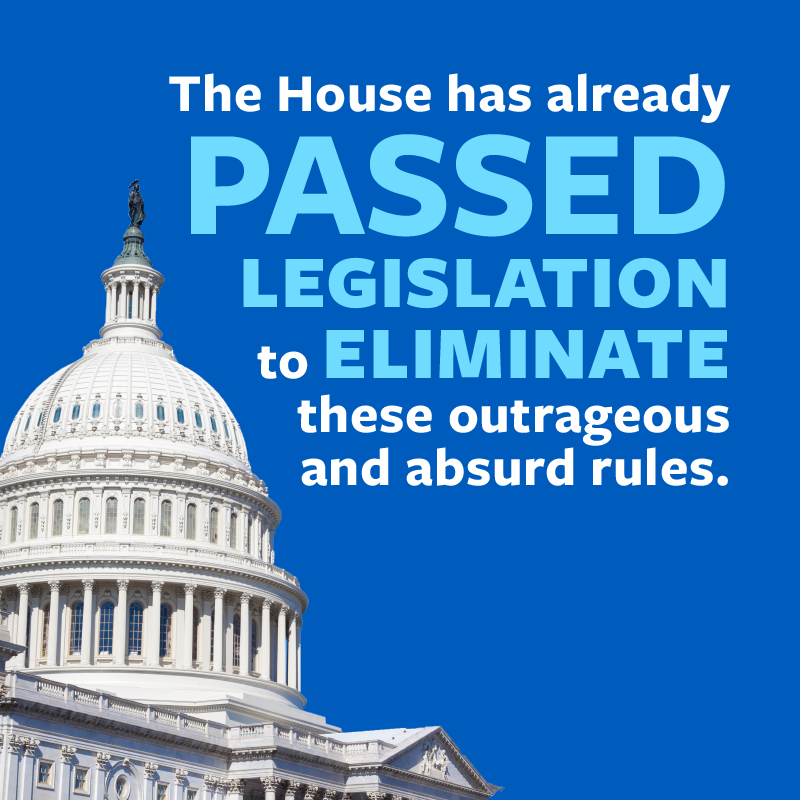



AEA President Thomas Pyle issued the following statement:
“The Congressional Review Act is clear: once an agency submits an action to Congress, only Congress has the authority to approve or reject it. California’s waiver, which is a crucial element behind a nationwide electric vehicle mandate, illustrates exactly why the CRA exists—to give lawmakers a say in major regulatory decisions.
“We want voters in Utah to know that Senator Curtis is the weak link here. In spite of expressing his support for giving voters a choice in the types of cars and trucks that best suit their needs, Senator Curtis is wavering in his support to end the backdoor EV mandate. Without his support, the waiver may remain in place, ensuring former President Biden’s electric vehicle mandate will live on, in spite of President Trump’s promise to end it. Senator Curtis must protect consumer choice for Utahns and stop unelected agencies from controlling the future of American transportation.”
Background:
The waiver allows California to ban the sale of gas-powered cars by 2035 and permits 18 other states to adopt the same policy. A central issue is whether such EPA waivers fall under the Congressional Review Act (CRA), which gives Congress the authority to review and potentially overturn agency rules. Both the Government Accountability Office and the Senate Parliamentarian have challenged this, arguing that California’s waiver is not a rule subject to CRA oversight.
However, these waivers meet the CRA’s definition of a rule, as they have broad applicability across multiple states and significantly impact the national auto industry. Their sweeping regulatory effects and precedent-setting implications support this classification. The Trump administration also treated waivers this way, submitting them for congressional review.
On May 1, 2025, the House passed a CRA resolution to overturn the waiver. The measure now heads to the Senate, where a vote is expected this week. Senator John Curtis remains undecided—his vote could determine whether Washington bureaucrats succeed in their effort to cement former President Biden’s electric vehicle mandate.
AEA Experts Available For Interview On This Topic:
Additional Background Resources From AEA:
For media inquiries please contact:
[email protected]
On this episode of The Unregulated Podcast Tom Pyle and Mike McKenna discuss the fallout of recent Biden admin revelations, the battle over the “Big, Beautiful Bill,” and the future of the Inflation Reduction Act.
Links:
Stay Connected With The Show:
The Republican controlled Congress is now considering a plan to fully repeal President Biden’s poorly named Inflation Reduction Act (IRA) of 2022. There are many reasons to fully repeal the IRA; however, the “Green New Deal” elements are especially troubling.
The IRA’s energy subsidies are projected to cost taxpayers between $936 billion and $1.97 trillion over the next decade, with potential liabilities reaching up to $4.7 trillion by 2050. This enormous price tag makes a promising target for the Trump administration in its efforts to stop runaway spending.
Despite this being a slam-dunk for the Republicans, a group of GOP Representatives and Senators recently signed letters asking to protect the IRA’s fiscally irresponsible tax credits.
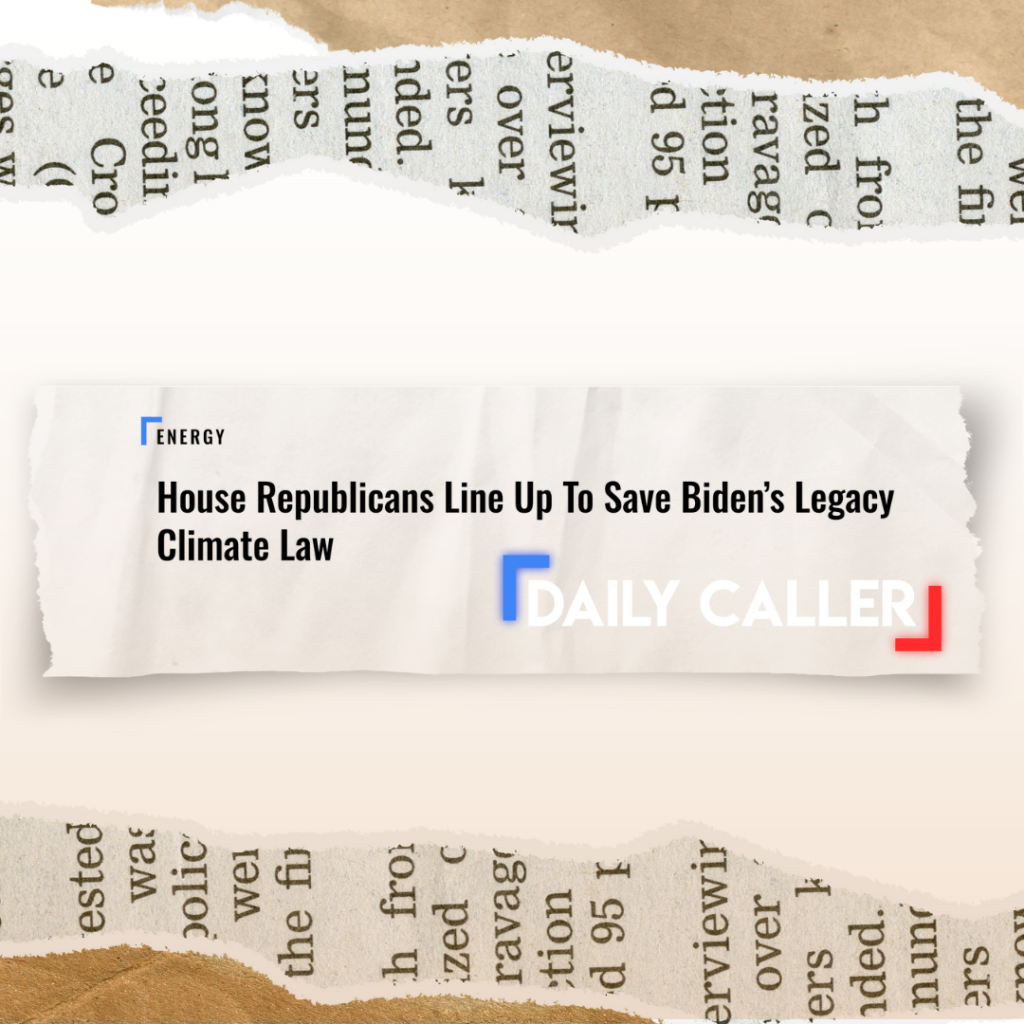
“We request that any proposed changes to the tax code be conducted in a targeted and pragmatic fashion that promotes conference priorities without undoing current and future private sector investments which will continue to increase domestic manufacturing, promote energy innovation, and keep utility costs down. We believe we can work together so that all these goals are achievable.” -Republican Letter-Signers (Full list below), March 9, 2025
Many of the signers were openly calling for the full repeal just a few short years ago. Here’s what they were saying before they had a chance to actually make a difference:
Sen. Lisa Murkowski (AK)
“It contains hundreds of billions of dollars in new spending, and hundreds of billions more in new taxes that will burden the American people and American businesses for years to come. Even floor debate – with amendment votes starting just before midnight on Saturday, and continuing through Sunday afternoon – was designed to avoid public awareness and scrutiny…There is no doubt in my mind, based on both substance and process, that the Senate should not have passed it.” –The Center Square, August 8, 2022

Sen. John Curtis (UT)

“This bill, the Inflation Reduction Act (despite multiple studies showing it won’t reduce inflation) is not transformational. The only transformational thing about the Democrats’ tax and spending spree is how it will raise taxes and give the federal government massive command and control over our economy and in people’s lives. In a twist of irony, the bill will tax and audit the middle class to give money to the Democrat’s preferred large corporations to invest in decarbonization. We should be protecting the middle class from increased energy costs, not using them to subsidize corporate tax credits.” –Congressional Western Caucus, August 15, 2022
Sen. Thom Tillis (NC)
“It’s an insult to the intelligence of North Carolinians when politicians like President Biden and Governor Cooper claim that raising taxes and spending $740 billion on their far-left priorities will actually reduce inflation and stop the Biden recession.”

Sen. Jerry Moran (KS)

“The idea that spending more money and increasing taxes will be helpful in combating inflation is false and confirmed by the Congressional Budget Office. Rather than taking steps to curb spending and expand energy production, the so-called Inflation Reduction Act will raise taxes on small businesses and working families, including by hiring 87,000 more IRS agents to target more Americans with tax audits. Instead, the Senate should be focused on pro-job, pro-growth policies to reduce the cost of gas, goods and services for Kansans.” -Office of Senator Jerry Moran, August 7, 2022
Rep. Andrew Garbarino (NY-02)
“This bill means $745 billion in new spending, including over $400 billion for the ‘Green New Deal’ and $80 billion in new funding for the IRS to hire 87,000 new agents to go after the middle class and small businesses…This bill is bad for Long Islanders and bad for the American people. Shame on Congressional Democrats for forcing through this irresponsible legislation to score a political win at the expense of American taxpayers.” -Office of Congressman Andrew R. Garbarino, August 12, 2022

Rep. Mark Amodei (NV-02)
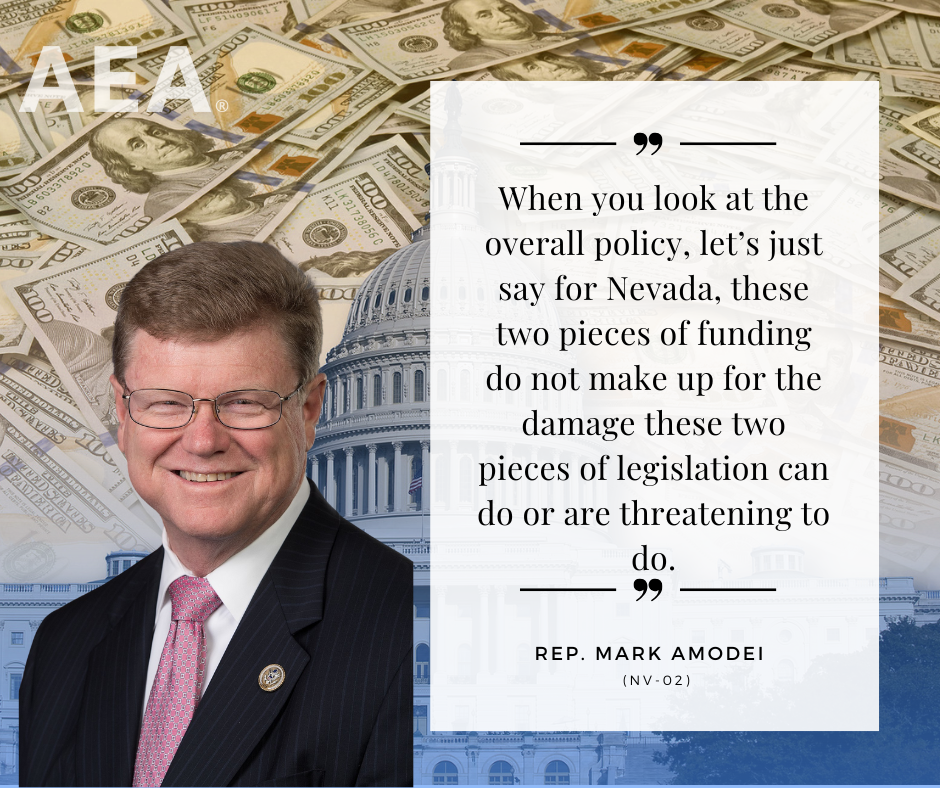
“When you look at the overall policy, let’s just say for Nevada, these two pieces of funding do not make up for the damage these two pieces of legislation can do or are threatening to do.”
Rep. Don Bacon (NE-02)
“This reckless and partisan bill is bad for Nebraska families, bad for Nebraska businesses, and bad for America’s energy sector. Democrats have been misinforming the American people on what’s really in this bill, and even President Biden’s favorite economist, Mark Zandi, says it won’t reduce inflation. We can’t keep asking the American taxpayers to shoulder the burden for the Democrats’ reckless spending.” -Office of Congressman Don Bacon, August 12, 2022

Rep. Dave Joyce (OH-14)

“The Majority just created hundreds of billions of dollars in new spending and implemented hundreds of billions of dollars in tax hikes. Those of us who live in the real world know that Washington can’t tax and spend its way out of this inflation crisis. That’s why I voted no.” -Congressman David Joyce, August 12, 2022
Rep. Tom Kean Jr. (NJ-07)
“Fiscal policy should be guided by what economists are saying, not Nancy Pelosi. Tom Malinowski just voted YES on a Liberal Spending Spree that will raise your taxes and hire 87k new IRS agents that will target New Jersey’s families.”

Rep. Buddy Carter (GA-01)

“The Inflation ‘Reduction’ Act is full of empty promises that harm some of Georgia’s flagship companies. In an ironic and careless twist, this legislation punishes one of Georgia’s largest employers and local providers of electric vehicles (EV), Kia Motors.” -The Atlanta Journal-Constitution, September 16, 2022
Rep. Young Kim (CA-40)
“The only thing the Inflation Reduction Act is reducing is the amount of hard-earned money in the wallets of American taxpayers.”
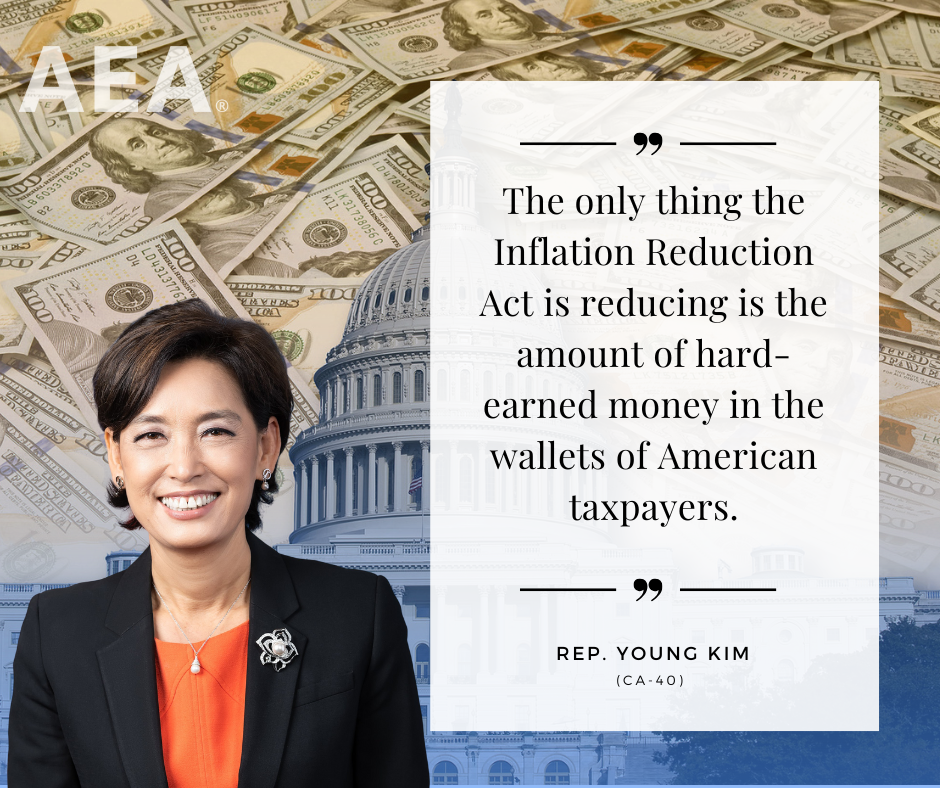
Rep. Mariannette Miller-Meeks (IA-01)

“This enormous spending package is bad for Iowans, bad for patients, bad for the economy and hardworking Americans, and bad for the future of American innovation.”
-Office of Congresswoman Mariannette Miller-Meeks, August 12, 2022.
Rep. Dan Newhouse (WA-04)
“President Biden’s policies have placed America’s food, energy, economic, and national security at risk and this bill will do nothing to reverse any of that. Instead this legislation will make our situation even worse.”
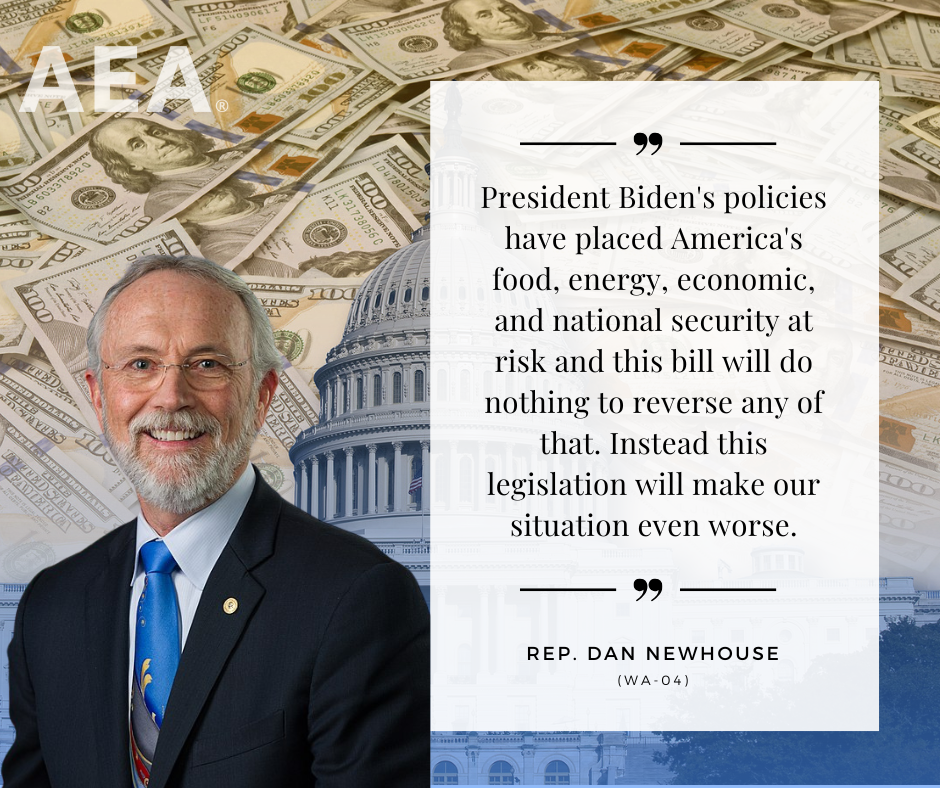
Rep. David Valadao (CA-2)

“The so-called ‘inflation reduction act’ is being paid for on the backs of hardworking, middle-class valley families struggling to put food on the table and gas in their cars. the law did nothing to lower prices, offshored our critical supply chains and jobs to China, and supercharged the IRS to audit more small businesses and working families.”
Send a message to Congress demanding they FULLY repeal Biden’s disastrous inflation bill using our tool below:













